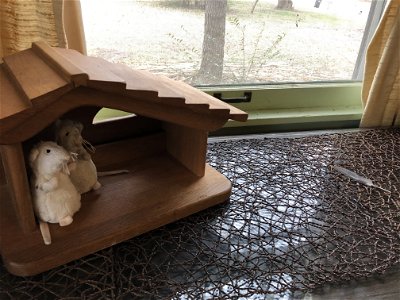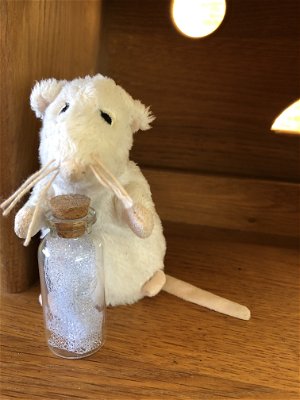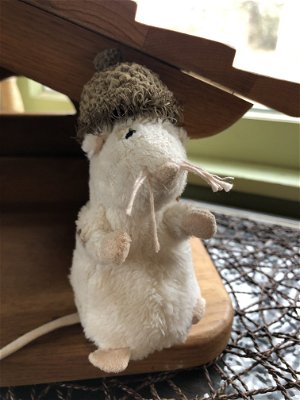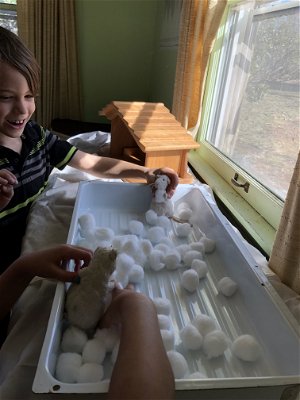Integer is a straight-up Latin word. In Latin it was an adjective that meant "intact, whole, complete." In other words, whole numbers (see graphic). Fractions and decimals need not apply.
It would be nice if we talked about the term "integers" earlier so it didn't coming zinging out of left field in Algebra. It's like how the equals sign means "is the same as" and not "put the answer here." The way that we introduce math concepts and vocabulary early on a child's school experience should set them up for success later on!
Anyway, if you're just beginning to do positive and negative numbers with your child, I want to pass along what Jamie York says about avoiding using a Number Line. A positive and negative bank account balance is a better real-life example and is more concrete and easy for children to understand. (A number line is helpful for coordinate graphing but I wouldn't use it for this.)
The three operations with positive and negative numbers are adding, multiplying, and dividing. There's really no subtracting, because we teach children to now think of subtracting as adding a negative number. 7 - 5 is rewritten as 7 + (-5).
The scoring in golf is also a great real-life example of this, and I highly recommend the Educational Game: Gnoming A Round for a wonderful introduction to adding positive and negative numbers!

Practicing multiplication and division with positive and negative numbers can be a little more difficult to understand. Here are my recommendations:
First, begin by reviewing fact families.
Fact Families Freebie Multiplication & Division
FREE at TpT
Then, go over the Rules. In my opinion, you should ignore the positive and negative signs, solve the problem as usual, then take the positive and negative signs into account when deciding what the final answer will be.
P x P = P
this one is obvious!
N x N = P
two negatives cancel each other out, like "she doesn't hate blueberries"
P x N = N
N x P = N
is there's cancelling out in this situation? no, so the answer will be negative
Lastly, remind students of the relationship between multiplication and division. This is the reason for practicing fact families first. (I've seen Rules for division, similiar to the Rules for multiplication, but I think there's no need to make it that complicated.
There really aren't two sets of rules.)
Dividing Negative Numbers Guided Notes
FREE at TpT
If the problem is 24 ÷ (-8), I just think to myself, what times negative 8 would give me a positive 24?
3 x 8 is 24. 3 x -8 would be -24.
So, for the 24 to be positive, the answer MUST be -3.
I like doing it this way better because it stregthens so many other skills. It reinforces the multiplication Rules, it doesn't muddy the waters with another set of Rules, it reinforces the basic understandings behind fact families... AND it helps you practice solving for a mystery number and reorganizing the problem in a different way, which are important concepts in Algebra.
Dividing Negative Numbers Worksheet
FREE at TpT (you should do Order of Operations first)
The first is a Three Sisters Garden; we will be using Native American Gardening: Stories, Projects and Recipes for Families by Michael J. Caduto and Joseph Bruchac.
The second is a Cob Bread Oven; we will be using Build Your Own Earth Oven by Kiko Zenzer and Hannah Field.
If you've been keeping up with the color coding we use in our plan books, you'll know that these projects combine three colors! They are Purple for Practical Life, Blue for Mathematics, and Green for Science & Nature.
(Building cardboard boats for the 49th Annual Great Cardboard Boat Regatta on April 20th has been another real-life measurement project for this school year. It takes 30 hours to make a boat, so we began way back in January.)
Here are my notes for this year's garden planning & planting:
pumpkin (baby plants) - donated by Miss Bridget
corn (baby plants) - donated by Miss Bridget
sugar snap pea (seeds) - donated by Miss Bridget
sunflower (seeds) - donated by Miss Bridget
Ashy Sunflower
order sunflower seeds - direct sow
Elves Blend
Evening Sun
Goldy Honey Bear
Lemon Queen
Moulin Rouge
Shock-O-Lat
Sunspot
Vanilla Ice
order bean seeds - direct sow
Lazy Housewife
Marvel of Venice
Rattlesnake
Scarlet Runner
Mon Apr 15
brainstorm units of measurement; write each one on a slip of paper
work in small groups to arrange the paper slips into categories
compare how the other group's arrangement is similar to or different from your group's
notice that there are both Imperial and Metric units
choose location for the Three Sisters Garden (our old Mulch Mountain, which has been the Heirloom Pumpkin Patch for the last few years and has volunteer pumpkin plants already sprouting in it)
review how to use a yardstick
work in pairs to measure the garden; sketch it on graph paper
Tue Apr 16
read "Understanding and Appreciating Other Cultures," pp.21-23
review units of measurement; consider a new way of grouping them
discuss the organization of the metric system (base unit + prefix), look at the prefixes for x10, x100, x1000 (based on Greek words) and ÷10, ÷100, ÷1000 (based on Latin words)
redraw yesterday's garden sketch on a fresh piece of graph paper; add color, title, and key (scale: 1 square = 1 yd / 3 ft / 36 in)
add garden map to MLB
rough draft and add list of plants in a Three Sisters Garden to MLB
sketch bee swarm as it arrived at our swarm trap! (on Sunday afternoon a beekeeper from Dayempur Farm put a swarm trap in our bald cypress tree, as he does every year, and we saw bees scouting it during recess... then, when we were outside sketching, the entire swarm arrived and moved into the box while the children watched!)
This post contains affiliate links to materials I truly use for homeschooling. Qualifying purchases provide me with revenue. Thank you for your support!
PLEASE PLEASE PLEASE check the manufacturer listed on the back of your solar eclipse glasses to confirm that they are on this American Astronomical Society list of Suppliers of Safe Solar Viewers & Filters.
I know that a lot of educational videos are floating around right now...
and
I just want to take a second to recommend Jamie York's new one, The Geometry of a Solar Eclipse, if you're going to share a video with your child.
I love that he includes the annular eclipse as well as the total solar eclipse, so that you can see how and why they are different. All of Jamie's work is spectacular and I highly recommend his curriculum guides, math workbooks (for middle school and higher), and online teacher training workshops. I've also visited his home in Boulder CO when I was out there for a puppetry training with Suzanne Down. He's a very nice person!
also
See Think Wonder (PDF)
pz.harvard.edu
24 Andy Goldsworthy Art Examples - FREE at TpT
Andy Goldsworthy Fact Cards (PDF)
teachingideas.co.uk
Andy Goldsworthy and Land Art
artuk.org
trailer for Rivers and Tides - Piffl Medien
trailer for Leaning into the Wind - Piffl Medien
trailer for Leaning into the Wind - Magnolia Pictures
Morning Altars: A 7-Step Practice to Nourish Your Spirit through Nature, Art, and Ritual by Day Schildkret
week of Apr 1
Wed
look at images in Andy Goldsworthy: A Collaboration with Nature
brainstorm what kinds of materials we have available to make Land Art in our location
do Create Your Own Land Art activity with sticks, leaves, wool yarn, and paint
the kids LOVED this! the house was so quiet while they were working, and an hour was definitely not enough time
Thu
week of Apr 15
week of Apr 22
week of Apr 29
This post contains affiliate links to materials I truly use for homeschooling. Qualifying purchases provide me with revenue. Thank you for your support!

Background:
Two years ago, I wrote the following in my Grade 1 Ruzuku Course:
At first I was thinking about Petunia (we love the books by Roger Duvoisin) but writing "Petunia" over and over seems tiring. Also, I was about to spend $85 getting the rest of the books in the series -- so that I could explain to them about what a series is and how sometimes children love a character so much that the author writes lots of stories about his/her adventures -- when I thought, Renee, surely there are other characters that have a series about them that you already own!
And then I thought, I could be the storyteller and make up stories (that would be modeling... and free).
And I remembered that we have two little white stuffed mice. One was from a toy the girls had when they were little and the other we found last summer at a neighborhood toy giveaway. They are identical! I began to think about the adventures of Mama and Papa Mouse. Mice are easy to draw and MAMA and PAPA are both easy to write and easy to learn to read!
All of that led me to the idea of having a container story for the Four Seasons block. I set up Mama and Papa Mouse on the dining room buffet along with our little wooden house. Each day they can have an adventure which also introduces the activity that I want us to do for the season we are studying. At the midway point (our Feb break) and ending point (our Mar break), I can send home the Primary Journals and encourage them to continue the Summer and Winter adventures of Mama and Papa Mouse!
I'm excited about this idea and happy to share our stories and activities for each day!
Update:
Well, we have loved Mama & Papa Mouse so much. The Four Seasons block, a classic Waldorf grade 1 block, is delightful. It's fun to travel through all four seaons back to back. Sipping hot chocolate at the "wrong" time of year! Having a snowball fight with cotton balls. Making up a sensory bin and experimenting to figure out a household item to fill it with that would make the perfect sound of jumping in an autumn leaf pile (hint: it's onion skins).
I also realized that it levels up the writing requirement in grade 1 in a perfect way. During the Capital Letters block, they begin by writing just one letter and then advance to writing a word. Now that we are doing a MLB about the adventures of Mama & Papa Mouse, children can choose to write a phrase, or even a sentence if they want that additional challenge. No stress about spelling at this age. They dictate, I scribe, they copy the spelling. It allows them to just see the letters that go with the sounds in the words they've picked to write.
Here are all the adventures Mama & Papa Mouse have had so far. For each I tell a short story (less than one minute) and we have a follow up activity. Then the next day they do the MLB drawing and add the words they want.
If children have a lot they'd like to say, I will share the writing with them:
2022 Stories
SPRING
Mama and Papa Mouse and the Rosy Pink
Mama and Papa Mouse and the Feather
Mama and Papa Mouse and the Ice

SUMMER
Mama and Papa Mouse and the Ocean
Mama and Papa Mouse and the Shadows
Mama and Papa Mouse and the Butter

Mama Mouse churning butter
AUTUMN
Mama and Papa Mouse and the Acorns
Mama and Papa Mouse and the Mushrooms
Mama and Papa Mouse and the Leaves

Papa Mouse with his acorn cap hat
WINTER
Mama and Papa Mouse and the Winter Day
Mama and Papa Mouse and the Hot Cocoa
Mama and Papa Mouse and the Snowball Fight

2024 Stories
SPRING
Mama and Papa Mouse and the Easter Egg
Mama and Papa Mouse and the Persimmon Tree
Mama and Papa Mouse and the Baby Birds
our indoor baby persimmon tree, just waking up from its winter sleep
SUMMER
Mama and Papa Mouse and the Bees
Mama and Papa Mouse and the Sunny Day
This post contains affiliate links to materials I truly use for homeschooling. Qualifying purchases provide me with revenue. Thank you for your support!
Monday
- Easter Egg Averages (TpT)
Mean, median, mode, and range for 5 eggs drawn from a basket. Students can make it easier or harder by creating the numbers to go inside the eggs.
Tuesday
- Describing Probability Outcomes Task Cards (TpT)
- Probability Activities 1, 2, and 3 from this past blog post
Instead of socks, we used a basket of glass gems (2 blue, 4 red, 6 white).
Wednesday
- Probability Review Game (TpT)
We will just do this as a regular PPT. I plan to play slides 6 through 21.
Thursday
- Egg Russian Roulette on our bare feet!
8 hard cooked eggs. 4 raw eggs.
This was a huge hit.
It's also a good use for an old shower curtain that you plan on throwing away anyway! We stopped and calculated the probability of choosing a raw egg each time. Thank you to my friend Megan for the donation of the eggs!
Zac's bedtime read aloud story for April is Charlie and the Chocolate Factory by Roald Dahl. We are just up to the part where Charlie is hoping to find a golden ticket. Veruca Salt's father made sure she'd get a ticket by buying and opening up hundreds of thousands of chocolate bars. Charlie gets only one for his birthday each year. Talk about a perfect tie-in with probability!
Some good board game choices if you're interested in more with probability are Yahtzee, Backgammon (see Fun with Board Games), and Monopoly! Illinois Avenue is the most common spot to land on (and here's why).
This post contains affiliate links to materials I truly use for homeschooling. Qualifying purchases provide me with revenue. Thank you for your support!
Waldorf curriculum conversations... Integration and places of intersection of Waldorf ideas with traditional approaches, homeschooling, Montessori and Reggio methods, and academia. Linked to waldorfcurriculum.com. Amazon Affiliate links are included in both my blog and my website.
Completed boats, ready for transport! the lovely mermaid, Pearl the trusty lifeboat, Ever

Grades 1 - 8
How to Teach Spelling:
SWI in the Waldorf Environment

Other Ruzuku courses available:
Grade 1
 Immersive Experience
Immersive Experience
Grade 2
 Immersive Experience
Immersive Experience
Grade 3
Grade 4
Grade 8
doing my Waldorf Handwork Teacher Training
see my full profile on LinkedIn